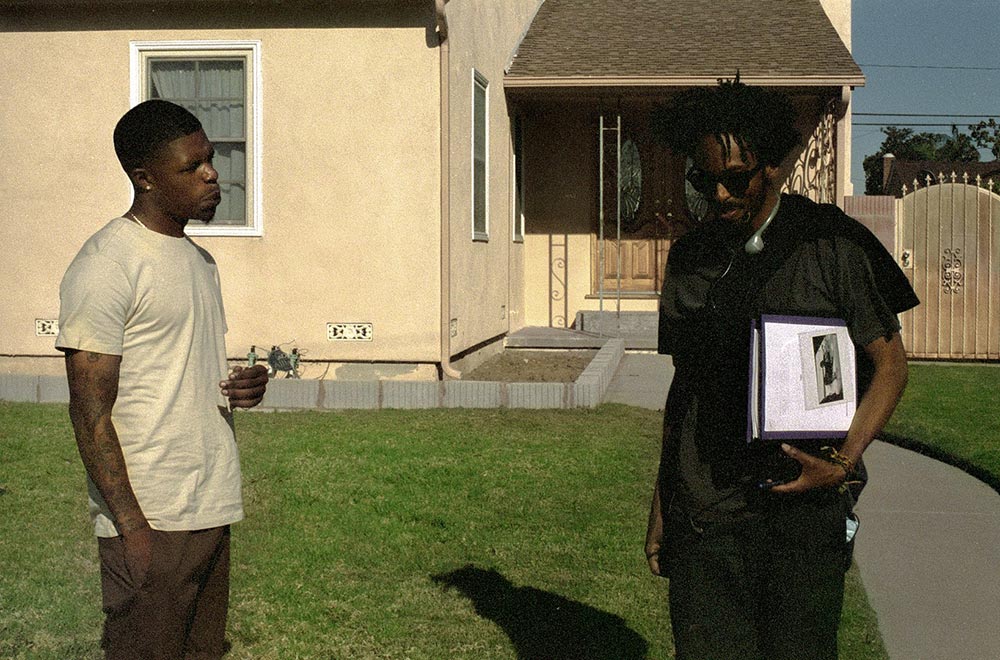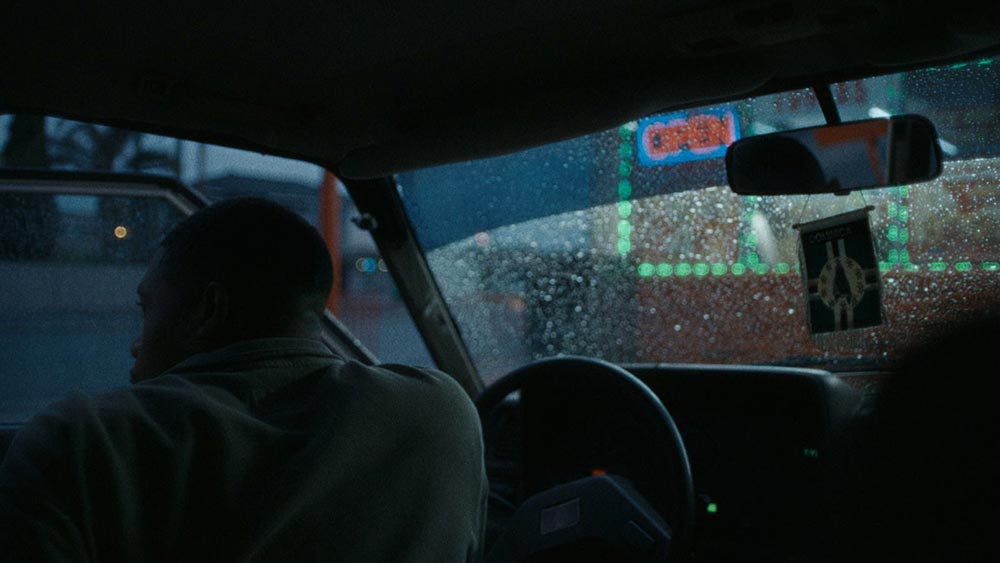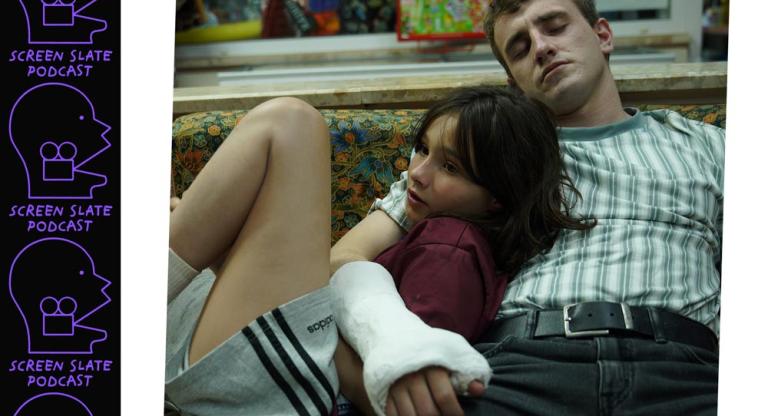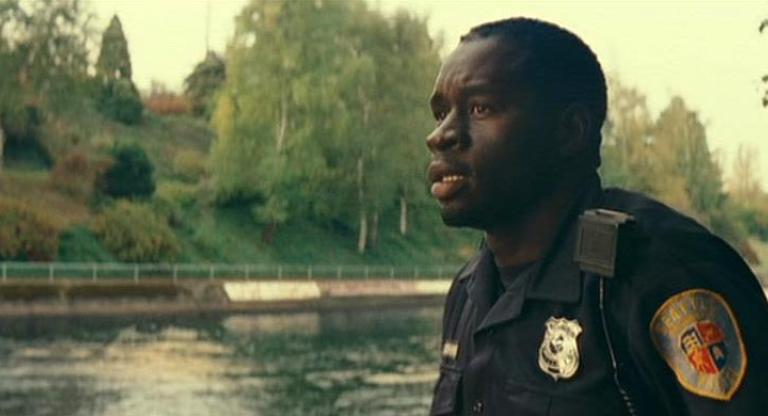Dwayne LeBlanc’s Civic (2022) is the kind of film I hoped was being made somewhere out there. It knows the place, the stakes, and refuses to shrink back from the demands of its own form. A young man named Booker returns home and drives around his old Los Angeles haunts. We never leave the car, even in the brief moments when Booker does. We don’t know much about where he’s been or why he is back. Absence makes the heart grow fonder, but wherever it is a gulf opens up.
The simple premise gives more space for an emotional investigation of the situation. New experiences don’t quite fit the old, shared language. LeBlanc does not pursue the well known conflicts that might erupt between those who go and those who stay. His film traces the unnamed chagrin that passes between loved ones who cannot project onto one another like they used to. Although the short film is episodic, each character appears fully formed. It is apparent in its constructions that we are only getting a small glimpse of their relationship with Booker, but the ease and specificity of their performances, and LeBlanc’s rigorous attention to detail and rhythm, make clear that these people spill beyond the frame.
I spoke with LeBlanc about the production, the writing process, and making the air feel thick. He wears his influences well, citing David Hammons, Ralph Ellison, and Chantal Akerman without imitating them. Akerman’s legacy is evident in his approach to pace and duration, even as he adapts some of those old means to press his own concerns. Civic is only twenty minutes, but it’s enough time to let love’s mutations unspool before us.
Blair McClendon: What drew you to this as the story you wanted to tell?
Dwayne LeBlanc: I was really interested in the frame within a frame. Being from from L.A., I spend a lot of time in the car. How the film was structured, that came before the narrative. And then I started thinking more and more about migration, and how those things are connected to identity. I wanted to tie that into a very, very classic story: someone coming home. Nicole Otero is the co-writer on this film, we spent a lot of time dialoguing about the characters.
BM: The thing about pretty much every road movie is everything has to be episodic. In constructing these episodes, what were you thinking about as you were figuring out the order and arrangement? Did that change in the post-production process?
DL: When [Nicole] first saw a cut, she was like, “It feels like a mixtape.” The structure, the order, definitely changed in the writing. I had to put a scene that was actually at the end in the middle. I think [the] edit is pretty much in the order [of] the script, which is kind of amazing. I mean, we're cutting out half of [the] scenes and stuff like that, too. The quick kind of flow and mixtape feeling was intentional in the script structure.
A lot of this has to do with proximity. Literal proximity, like how close [are] the cameras to the character? And then different types of proximity, like “who's watching this film?” Is a Black person? How does that change how much they understand, as a Black person from America? How much of the language can they understand?
I wanted to play with visibility and invisibility. At some points, you're really, really aware of the characters that you're looking at, and sometimes you forget. Sometimes I want [the audience] to slip out and forget a bit about what they're looking at. That’s why I wanted such a simple narrative—a way for them to forget themselves and to maybe forget the character and play between those things.

BM: On visibility and invisibility: I love when things are in the dark. It’s great how unafraid this movie is of the dark. In the first night they are almost completely in shadow, and then there's a lighter shadow cutting across their faces. How did you guys prepare for those? What attracted you to all that darkness?
DL: I got to talk about Kerry James Marshall and Ralph Ellison, David Hammons. They use a lot of literal invisibility in the material. And I wanted to speak to that in the film. Andrew [Yuyi] Truong, who ended up shooting the film, we talked a lot about this. Even as I was constructing the script, I thought about not showing the main character. You won't be able to physically see him, and it was intentional that he's shot in so much darkness. Can the audience empathize with a character they can't necessarily see? My theory is yes. All the characters he's interacting [with] are projecting onto him, or him to them. Andrew really helped me trust the vision more. There's subtle things. There’s a tinted strip on the top of the frame of the windshield and that ended up playing a big role into how shadows fell onto the faces and ended up adding so much richness and texture. I wanted to find a lot of tonality and range within blackness, too.
BM: I got to ask a question about everybody's favorite girl since you gave a thanks to her—Chantal. What this film is good at is the air feels thick in the same way it feels in Chantal Akerman’s movies. How did you approach cultivating that palpable sense?
DL: La Chambre [1972], that was my first film that shifted everything for me. That was a film that was like, “Wait, I don't even know if I like this,” but I watched it 20 more times. I love this thing that Martine Syms says. She’s like, “I'm not really interested in being the first. I'm interested in continuing and being a bridge.” I think the way I had to approach this film— I think the reason why maybe the air feels thick is being super, super, super intentional. It took forever to cast that car. We were thinking about [the] shape of the windows and color and all these different things. Finding out which direction we're driving and when and for how long. Every single decision was so, so intentional to even the tints of the window. We drilled nine different holes into the roof. We really mapped them out a lot before we drilled the holes to figure out the placement of the camera for each individual scene. So I bring this up all to say, when I think about Chantal I think she's so dialed in and intentional with everything from framing to sound to rhythm. It took like three years with three or four different casting directors to finally land on someone who really understood it. When a character isn't speaking, how would they feel in the frame? What are they doing when they're not speaking? Let's think about silence and then thinking about when things aren't moving. It's not just duration for duration’s sake.
BM: Where do you think this film takes you next? What worked here? What didn't work that you think you're going to carry on into the rest of your work?
DL: I'm making a trilogy out of this. The other two films are wildly different, only the themes are similar, but the shape of how I approach them will be very, very different. Civic, having the success it has—my next two films will be more extreme, more challenging, potentially. Seeing how things, and if things will, crossover and still be able to not alienate my community, my mom, my neighborhood and my community members, and my filmmaking community. Part of me is a little bit nervous. Another part of me is really excited to experiment more and see how people interpret the next works.
Civic screens tonight and tomorrow, March 31 and April 1, at Film at Lincoln Center and the Museum of Modern Art, as part of New Directors/New Films 2023 in “Shorts Program I.” Director Dwayne LeBlanc will be in attendance for a Q&A.





